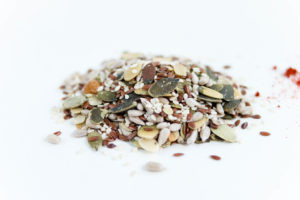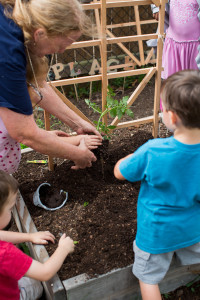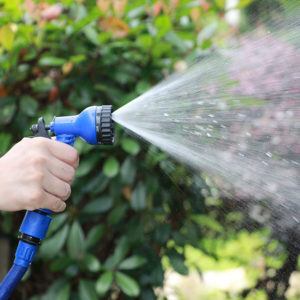 ELC preschool educator Michelle Combs loves the outdoors and enjoys introducing children to the wonder of the garden. For Earth Day, she has developed this piece to help adults think about how to include children in gardening experiences at home. Michelle’s co-teacher, Kathryn, has posted a piece about going outside with children in honor of Earth Day- check it out when you’re done with this one!
ELC preschool educator Michelle Combs loves the outdoors and enjoys introducing children to the wonder of the garden. For Earth Day, she has developed this piece to help adults think about how to include children in gardening experiences at home. Michelle’s co-teacher, Kathryn, has posted a piece about going outside with children in honor of Earth Day- check it out when you’re done with this one!
I have developed the following suggestions for ways to explore gardening concepts with young children. Curious children using materials found in nature will want to explore while asking questions, problem-solving, and increasing their confidence and abilities to share ideas. Take a look and let us know if you tried any at home!
 Exploring Seeds Exploring seeds with children offers several possibilities for learning about where our food comes from and how things grow. Prompting questions, theories, and concepts to explore might include:
Exploring Seeds Exploring seeds with children offers several possibilities for learning about where our food comes from and how things grow. Prompting questions, theories, and concepts to explore might include:
- Seeds come in all shapes and sizes. A tiny mustard seed can become a giant flowering plant. How do you think that happens?
- Where do we find seeds?
- What do you think seeds look like?
- Do you see any seeds in a garden?
- Most plants we find in the garden start out as seeds. Some are so small you might need a magnifying glass to find them.
- Are there seeds inside the foods we eat?
- With parents’ permission and assistance, children can investigate the inside of some vegetables and fruits such as an apple, a cucumber, pepper or watermelon. Carefully remove the seeds from the veggies and fruit, and spread the seeds out, comparing and contrasting the different types of seeds.
- If you buy seeds in packets from a store, sort the seeds by size, shape, color, etc. before planting. You can use a magnifying glass to get a better view of the seeds.
- Seeds are very small but they contain the possibility of a great big plant inside them. Use this link and this link to find out more about seeds and how to care for our gardens.
 Growing Vegetables without Seeds Did you know that you can start sprouts from vegetable and fruit table scraps? One example is using the remnants of veggies such as celery and green onion bases and place them in shallow dishes of water. Place them by a bright window and watch them sprout new harvest growth. Avocados and potatoes can also be started from the vegetable itself. Seeds from tomatoes and peppers can be planted in pots or the garden as well. So, if you have vegetable and fruit table scrapes try this experiment. See a link here and here to learn more about replanting table scraps.
Growing Vegetables without Seeds Did you know that you can start sprouts from vegetable and fruit table scraps? One example is using the remnants of veggies such as celery and green onion bases and place them in shallow dishes of water. Place them by a bright window and watch them sprout new harvest growth. Avocados and potatoes can also be started from the vegetable itself. Seeds from tomatoes and peppers can be planted in pots or the garden as well. So, if you have vegetable and fruit table scrapes try this experiment. See a link here and here to learn more about replanting table scraps.
Seed Spheres Do you have an area with bare ground? Why not plant some seed spheres? How to make seed spheres:
- Put some soil in a bowl, pail, or bucket that you don’t mind getting dirty.
- Add enough water to get a clay-like texture that you can sculpt with your hand.
- Add more water if the soil is too dry and more water if too wet.
- Sprinkle your seed mix into the mud. I would recommend native wildflower seeds that can be broadcast. Mix thoroughly.
- With your hands scoop up enough mud to roll a small ball (about the size of a gumball and no bigger than a golf ball).
- Place your seed spheres on a flat surface where they can dry in the sun.
- Once the seed spheres are dry, toss them on the ground where you wanted to plant them.
- Water regularly, and watch the seeds grow. Draw or write in a garden journal what you notice. For more information, visit Back Pocket Learning.
Chart the Weather Gardeners always start their day looking at their plants. Did you know the physical appearance of plants changes due to the weather? We can learn a lot about plants by observing and charting how they react to changes in the weather. Explore your garden on a daily basis. Keep a journal of drawings and/or write what you notice. Questions/prompts to think about:
- What is the weather like today, is it sunny, cold, wet, or dry?
- Is the wind blowing?
- What do you notice about the plants in your garden on these different kinds of days? What do they look like?
- How do you feel or react to the different types of weather?
- Are the seeds starting to sprout?
- Are the plants growing up, out or falling over?
This link has more information about making a weather journal.
 Discovering Dirt Seeds need water, sun, and good dirt to produce healthy plants. Explore the dirt in your yard and offer these prompts as guiding questions for exploration:
Discovering Dirt Seeds need water, sun, and good dirt to produce healthy plants. Explore the dirt in your yard and offer these prompts as guiding questions for exploration:
- Dirt comes in all types: sandy, rocky, clay, and soil mixture (ground-up rock, sand, rotten plants). What kind of dirt do you have in your garden?
- Which dirt type do you think your plants will like best?
- Explore the dirt in your garden by making mud pies. Does the dirt soak up the water or does the water drain quickly through the dirt?
- Do an experiment with different types of dirt.
- Plant a seed in 3 recyclable cups using different types of dirt; sandy, rocky, and soil (mixture of dirt).
- Place the cups in a sunny spot and water daily. What do you think will happen?
- Take photos or use a journal to draw and write what you notice.
- Maybe this experiment will help you decide what kind of dirt or soil you need for your garden.
Click on this link for another science experiment with dirt.
Earthworm Hunt Did you know that earthworms are an essential part of keeping our plants and gardens healthy? They provide our soil with nutrients from their castings (worm poop!). Earthworms also help keep our soil soft and breathable by digging tunnels that aerate, or bring air, to the roots of plants. You can make a wormery or worm hotel by following these directions:
- Explore the garden or backyard to look for earthworms. Gently use your hands to rake through the soil or earth to find earthworms.
- When you find an earthworm, carefully scoop it into a clear plastic or glass container.
- Place some garden soil in the container.
- Put a few scraps of lettuce, bananas, or potato peels on the top of the soil.
- Watch the way the worms are moving in the soil.
- Do they go in straight lines? Curvy lines?
- Keep the soil moist for the worms and don’t forget to put them back in their habitat once you finish your worm research. For more information about worms, check out this video.
Following the Sun If you are planning a garden, you’ll want to start in springtime. An important thing to pay attention to is the amount of sun each plant will need. Where do you think your garden will be happiest? Some plants like lots of sunshine while others not so much, just like people have different needs. Colorful flowers love the sun but dark leafy greens, like kale, prefer a mix of sun and shade.
One way that you can tell which plants love sun versus which ones need a little shade is by looking at their leaves. Plants that like shade have wider, thinner leaves (so they can absorb more sunlight) while sun-loving plants have smaller, thicker leaves. Questions to think about when finding the best spot for your plants:
- Which direction is the sun coming from?
- What buildings or trees near our garden cast shade or shadows?
- Where is the sunniest spot in the garden?
- Is there anything already growing in the garden and what do you notice about the leaves?
- Does your body create a shadow in the garden? Which direction is it pointing to?
Other activities you may consider:
- Take seed packets and look at the growing instructions.
- Sort packets into sun-loving versus shade-loving plants. Some plants might like a mix of both.
- Draw a map of where in the garden you want to plant your seeds, based on what you observed about sun and shade.
- If there are any plants growing and casting a shadow, take another piece of paper and place it under the shadow. Trace the outline of the shadow. If you are near a sidewalk, use chalk to make outlines of shadows.
Click on this link and this link for fun songs about taking care of plants.
 How much water is enough? One of the most important jobs of taking care of a garden is to make sure that our plants are staying happy and healthy. Water is essential in helping our gardens to grow and flourish. The type of soil in the garden determines whether or not plants will be able to absorb the water we give them. It’s important to observe and discover how much water is the right amount of water. If our gardens don’t receive enough water, our plants will dry out. If they are overwatered, they could drown. Here are simple ways that you can test the soil to make sure that it is receiving the right amount of water.
How much water is enough? One of the most important jobs of taking care of a garden is to make sure that our plants are staying happy and healthy. Water is essential in helping our gardens to grow and flourish. The type of soil in the garden determines whether or not plants will be able to absorb the water we give them. It’s important to observe and discover how much water is the right amount of water. If our gardens don’t receive enough water, our plants will dry out. If they are overwatered, they could drown. Here are simple ways that you can test the soil to make sure that it is receiving the right amount of water.
- Stick your finger in the ground and observe what you feel. Is the soil moist and soft or hard and dry? If it’s dry, then it needs a good watering. If it is very moist and the soil feels wet, then it has been watered plenty!
- Use a ruler and stick it into the ground. Push it gently down into the soil. When you pull it up is the ruler muddy or wet? If the soil is wet deep down, that means the garden has been watered well.
- Check the leaves on plants. Are they green and strong or are they drooping and brown? If they are drooping, they might not be receiving enough water.
- Record your observations in your journal and check back the next week to see how your plants are doing. It might take a few weeks to figure out just the right amount of water.
- Make sure you’re checking the weather too. When it’s hot you might need more water!
To learn more about absorption, experiment with different materials around the house to see what is absorbent, and what is repellent.
- Fill up a bowl or a large container with a small amount of water.
- Grab some material such as a washcloth, a plastic bag, a cork, a rock, a piece of bread
- Drop each item into the water, one at a time. Sort your findings into two piles; soaks up water and repels water.
Invitations and Provocations Find a place in the yard, garden, or sandbox that children can experience using real garden tools such as a trowel, hand fork, watering can, and child-size garden gloves. An adult should be close by the ensure the child is working safely with the tools. Place materials you have in your yard that would invite children to explore and investigate, using their hands to feel and touch provoking thoughts, ideas, and actions which may lead to deeper thinking.

This provocation includes flower petals, sunflower seeds, corn kernels, lambs ear petals, tweezers, and tape. What might a child do with the tape?
Additional Gardening Resources:
Little Green Thumbs, Inquiry Learning in the Garden
National Gardening Association and Kids Gardening Introduction to gardening for children, with practical tips for caregivers
Fun Gardening for Kids 30 Creative Outdoor Projects –Jenny Hendy
Gardening with Children –Hannemann, Hulse, Johnson, Kurland, Patterson
Tennessee Master Gardner Program
Grow More Good: Dig into at-home learning activities
Information about Reading Gardens
Caldecott award winning children’s books about gardens
Growing Good Kids – Excellence in Children’s Literature Awards